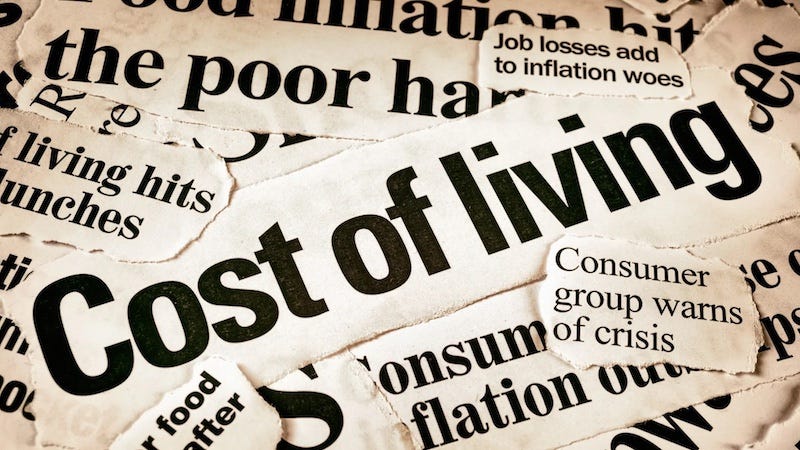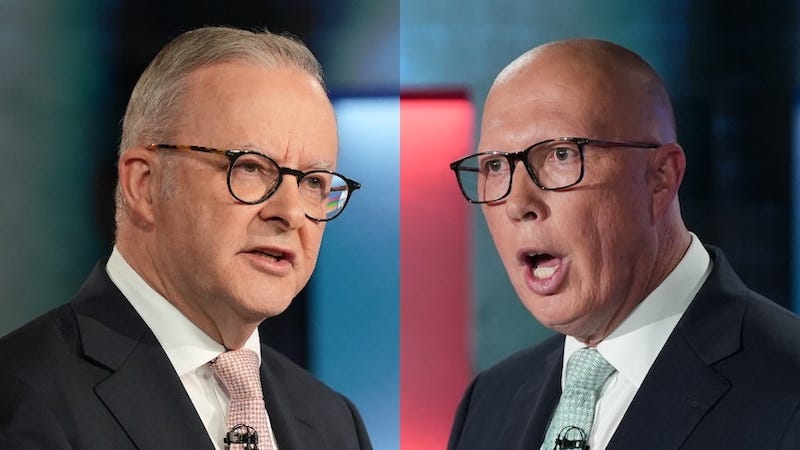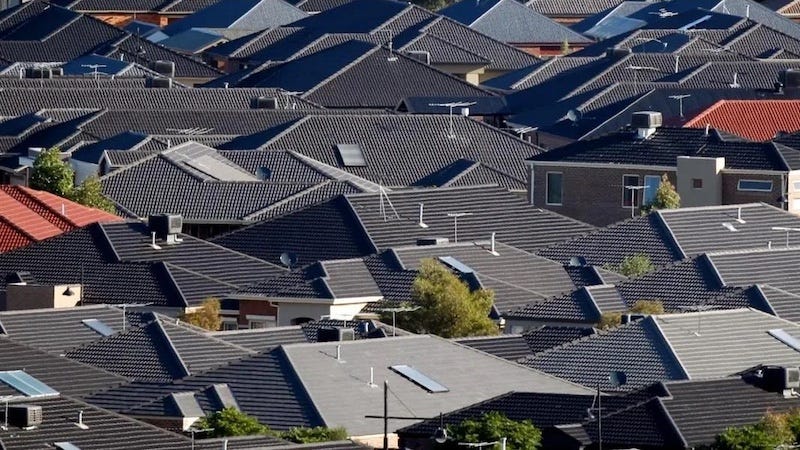A manufactured crisis: how cost of living fear is shaped for political gain
Whether the cost of living message is powerful enough to overcome the broader distrust in the political class will be found out in just a few days’ time.
We’ve been hearing a lot about cost of living issues throughout this election campaign, and it’s clear that this is being framed as the cost of living election. In fact, for most of this parliamentary term, the media has driven a continuous and sustained narrative that living costs are spiralling out of control, ever since the Labor government took office in May 2022 – even though inflation and price rises began during the final year of the Coalition government. This is always a difficult area to debate, because once you point out that things are not quite as catastrophic as the media portrays, you’re instantly labelled as out of touch, a privileged snob, or totally oblivious to the struggles of ordinary families.
There’s no question that prices, rents, and mortgage repayments have increased over the past three years, but this trend was already underway well before Labor’s term commenced. What is often overlooked is that the real underlying issue is not simply rising prices – it is the widening gap between the rich and the poor, a reality that neither the Labor Party nor the Coalition are seriously addressing. Instead, the political focus during this election has been firmly on soothing the anxieties of the middle and upper classes and ensuring that the billionaire class remains unprovoked.
Perhaps elections in Australia have always revolved around appeasing the middle class, promising hip-pocket relief to keep them onboard and worshipping the gods of neoliberalism, but it feels like this focus has become stronger and more performative in recent elections. It is a continuation of a strategy that dates back to Robert Menzies’ iconic 1942 ‘forgotten people’ speech, where he positioned the middle class as the moral centre of Australia – the self-reliant, stoic citizens who neither seek nor require government assistance. Menzies’ portrayal resonated because the middle class was expanding, driven by suburban growth from the 1920s and 1930s, accelerating after the World War II. However, since the neoliberal era – and particularly under John Howard – the middle class has steadily shrunk.
Today, a lingering aspiration persists, one that mirrors American mythology: that belief that poverty is only temporary, and even the struggling classes are simply ‘embarrassed millionaires’ awaiting their turn at prosperity if they work hard enough, a belief is being cynically weaponised during this election campaign. The Coalition’s promises of tax cuts for the wealthy – in conjunction with their message that living today is like a dystopian Dickensian era – are pitched not just to the rich but also to those who imagine that, someday soon, they too will be wealthy. It’s a politics built on aspiration and illusion, exploiting the dream that self-interest today will be rewarded with affluence tomorrow. In the meantime, the real and more uncomfortable truth – that wealth is concentrating ever upwards while economic vulnerability spreads downwards – is drowned out by the relentless clatter of the manufactured cost of living panic.
Leaders are fuelling cost of living panic without solving it
Throughout the election campaign, neither major party has focused on real solutions for those most impacted by poverty and economic hardship. There has been almost complete silence on increasing JobSeeker payments, assisting the unemployed, addressing youth unemployment, or improving the lives of people living in poverty. It’s as if the prevailing mindset, echoing the harshest aspects of the American system, is that anyone in economic distress must have failed personally and, because of this, is unworthy of political attention. As has been the pattern for decades, the entire election narrative remains tightly locked on hip-pocket issues and financial aspirations for those already doing relatively well.
The media’s constant hammering about a ‘cost of living crisis’ predominantly for the middle and upper classes creates a feedback loop: the more it’s emphasised, the more these groups demand government action to protect their lifestyles, and the more the political leaders respond by funnelling benefits and relief to them – largely ignoring the needs of lower-income and vulnerable groups. While some support does reach disadvantaged areas, the overwhelming majority of political promises and media attention remains firmly directed at middle- and upper-income Australians. This creates a dangerous illusion that everyone can and will become financially secure if only they vote a certain way, reinforcing a myth of endless upward mobility.
The old promises of trickle-down economics still linger. But with this illusion of the ‘trickle-down’ effect, the problem isn’t that the flow eventually goes past the brim and reaches those below – it’s that when the flow gets closer to the top, it’s simply replaced with a larger vessel: the promised trickle never appears, the accumulation remains at the top. It’s a brutal but accurate depiction of how political and economic structures have evolved.
The result is a deepening disillusionment with both major parties, fuelling record levels of informal voting and disengagement, especially among those who see their real issues – secure jobs, affordable housing, accessible healthcare – being ignored. Tax cuts for the wealthy? No problem. Defence spending? Unlimited. Higher education and Medicare? Pushed to the background.
The Labor Party has made a pledge to reinvest in Medicare, a modest but critical attempt to reverse the hollowing-out that took place under the Abbott, Turnbull and Morrison Coalition governments. Australia’s public healthcare system remains one of the best in the world, but it is increasingly under strain, and Labor’s commitment, if followed through and supported by any crossbench alliances if needed, could help preserve and even rebuild it. By contrast, Dutton has offered no serious proposals to strengthen Medicare – perhaps unsurprising given that when he served as Health Minister in 2013–14, he was infamously voted by Australian Doctor magazine as the worst health minister in Australia’s history.
It speaks volumes about the political priorities on offer in this election: a contest not about addressing real structural inequality, but about which side can better manage the anxieties of the comfortable classes while leaving the root causes of hardship untouched.
Where the real cost of living crisis will bite on election day
If this election is being framed as the ‘cost of living election’, it’s worth stepping back from the noise and looking at the reality behind the slogans and the avalanche of media messaging. While the media keep pushing the message of a ‘crisis’, the economic data offers a more complicated story. The consumer price index has gone down to 2.4 per cent, which is a significant decline from its peak of 7.8 per cent in 2022. The wage price index, which tracks growth in income levels, has risen to 3.2 per cent, the highest since 2009. Retail turnover has gone up by 8 per cent since May 2022, and overseas travel has almost returned to pre-COVID levels, with international trips and holidays now at 95 per cent of the volume in 2019.
Yes, there are many financial pressures, especially for mortgage holders and renters, who have seen significant rises in repayments and rental costs over the past three years. However, overall consumer sentiment paints a more gloomy picture than the statistics suggest – there is a mismatch between the economic data and public feeling, a gap that the media has played a large role in widening. The repetitive media depiction of a ‘cost of living crisis’ has created an atmosphere of fear and pessimism that is not entirely borne out by the figures. Media monitoring suggests a pattern: when a Coalition government is in office, national debt, inflation, and price pressures are often underreported or downplayed. When a Labor government is in power, these issues are pushed to the foreground, portrayed as existential crises regardless of the actual trends.
That is not to say there isn’t a real cost of living issue – there is. But the crisis is not uniform across society. Middle- and upper-income households are generally weathering the storm well, continuing to spend, travel, and maintain lifestyles, while lower-income households are genuinely struggling. It is among these lower-income groups where the real cost of living pain is concentrated, and neither Labor nor the Coalition have shown much appetite to address it in any systemic or transformative way.
This is where the electoral impact is likely to be felt by the government. In the traditional Labor strongholds – outer suburban electorates where mortgage stress, rent rises, and stagnant real wages bite hardest – discontent is simmering. This is a situation that was reflected in the 2022 Victoria election, where large swings occurred safe Labor seats in the outer Melbourne suburban ring, but not enough to lose the seats. This might not be enough to cost Labor government federally, but the margins in many previously safe seats could be slashed, turning once impregnable Labor seats held by 20 to 30 per cent, into marginal battlegrounds. Some seats could even be lost entirely, exposing Labor to a future election cycle where it has to defend a far narrower electoral map.
The marginal seats are where the cost of living debate will truly come alive on election night. Perhaps four or five seats could swing from Labor to Liberal, although even that might be an optimistic outcome for the Coalition. The Liberal Party is aggressively targeting these outer suburban areas, aware that their path back to power depends on winning over struggling families who feel abandoned. Yet despite the hard work of some local Liberal candidates, the Coalition’s broader problem remains: a lack of credible national leadership and a vision that can unite and inspire.
In local contests, it can often come down to a candidate promising a new hospital wing, a fix for dangerous local roads, or simply offering a visible presence in communities that feel neglected. These micro-battles are being fought out across Australia, often far away from the main media spotlight. Both Labor and Liberal strategists know this, which is why so much of the campaign effort is being poured into these small but crucial fronts. But without a strong central leadership offering a compelling alternative to the public, it is difficult to see the Coalition making the kinds of breakthroughs it needs to fundamentally change the election’s outcome. The cost of living narrative might be powerful – but whether it is powerful enough to overcome leadership deficits and broader distrust in the political class will be found out in just a few days’ time.












Excellent analysis. Thank you.
Terrific piece and the key insights are all well argued.
You are correct to point out that inequality is the principal issue here, with the distribution of pain highly uneven. Many are doing extraordinarily well out of this ‘crisis.’
The ALP’s tenuous and almost always temporary occupation of government has them permanently on the back foot, especially in view of the way the ruling classes can tightly manage the frame of reference for debate.
However the ALP must take significant responsibility for this as by stubbornly sticking to a defensive small target strategy and failing to reframe the agenda it plays to the strengths of the ruling class. Hence we get ridiculous arguments about the cost of eggs and ‘wasting’ money on benefits, education and healthcare while billions is sunk into the coffers of the American imperial war machine via AUKUS, and rebates to foreign extraction businesses along with tax evasion by international (mostly US) corporations such as Meta, News Corp and Alphabet drains and severely restricts our sovereign capital.
We are stuck with a choice between the vaguely competent management of decline with the ALP or highly partisan malignant incompetence from the LNP.
We need leaders, not managers.